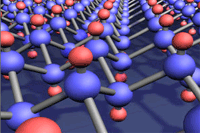Bilayer graphene: another step towards graphene electronics
12 Aug 2011
The Nobel Prize winning scientists Professor Andre Geim and Professor Kostya Novoselov have taken a huge step forward in studying the wonder material graphene and revealing its exciting electronic properties for future electronic applications.
Graphene electronics are becoming ever closer to reality
 Writing in the journal Science, the academics, who discovered the world's thinnest material at The University of Manchester in 2004, have revealed more about the electronic properties of its slightly fatter cousin – bilayer graphene.
Writing in the journal Science, the academics, who discovered the world's thinnest material at The University of Manchester in 2004, have revealed more about the electronic properties of its slightly fatter cousin – bilayer graphene.
The researchers, from the universities of Manchester, Lancaster (UK), Nijmegen (the Netherland) and Moscow (Russia), have studied in detail the effect of interactions between electrons on the electronic properties of bilayer graphene.
They used extremely high-quality bilayer graphene devices which are prepared by suspending sheets of the material in vacuum. This way most of the unwanted scattering mechanisms for electrons in graphene could be eliminated, thus enhancing the effect of electron-electron interaction.
The latter could be seen as strong changes in the low-energy electronic spectrum – it becomes strongly anisotropic, or directionally dependent. This is the first effect of its kind where the interactions between electrons in graphene can be clearly seen.
The reason for such unique electronic properties is that quasiparticles (electrons and holes, which carry electric current) in this material are very different from those in any other metals. They possess chiral symmetry (a symmetry between electrons and holes) of the sort which exist between particles and antiparticles in high-energy physics.


.webp)




























